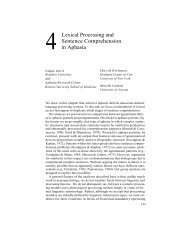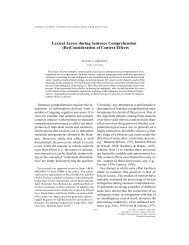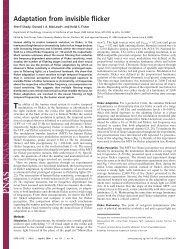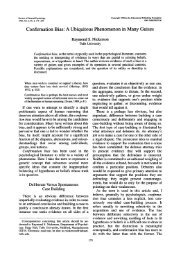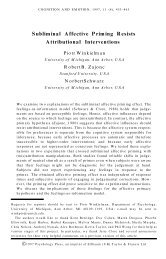Chapter 9 Moving verbs in agrammatic production
Chapter 9 Moving verbs in agrammatic production
Chapter 9 Moving verbs in agrammatic production
You also want an ePaper? Increase the reach of your titles
YUMPU automatically turns print PDFs into web optimized ePapers that Google loves.
154 Grammati cal disorders <strong>in</strong> aphasia<br />
In Spanish, verb agreement was also found to he much better<br />
preserved than tense <strong>in</strong>flection: us<strong>in</strong>g a sentence completion procedure,<br />
Benedet, Christiansen and Goodglass (1998) found that their six Spanishspeak<strong>in</strong>g<br />
<strong>agrammatic</strong>s produced only 5.5% correct verbal tense, but<br />
produced 63.8% correct subject-verb agreement. In English !they found a<br />
similar pattern of results for the seven <strong>agrammatic</strong>s they exam<strong>in</strong>ed, but<br />
with a smaller difference: the English-speak<strong>in</strong>g <strong>agrammatic</strong>s produced<br />
42% correct agreement and around 15% correct tense.<br />
The same was found <strong>in</strong> French: the <strong>agrammatic</strong> patient Mr Clermont,<br />
reported <strong>in</strong> Nespoulous, Dorda<strong>in</strong>, Perron, Jarema and Chazal (1988,<br />
1990), had only tense errors <strong>in</strong> spontaneous speech, but no verb agreement<br />
errors.<br />
The f<strong>in</strong>d<strong>in</strong>g of <strong>in</strong>tact agreement aga<strong>in</strong> rebuts the claim that <strong>agrammatic</strong>s<br />
do not have syntactic trees at all, or lack all functional categories<br />
(Goodglass and Mayer, 1958; Myerson and Goodglass, 1972; Caplan and<br />
Futter, 1986; Ouhalla, 1993). Without the lower part of the syntactic tree, a<br />
correct verb agreement would be impossible. This situation calls for a<br />
more ref<strong>in</strong>ed structural description that enables a dist<strong>in</strong>ction between the<br />
spared and impaired elements.<br />
What are the types of verb <strong>in</strong>flection errors across<br />
languages<br />
After delimitat<strong>in</strong>g the substitutions to a subpart of verb <strong>in</strong>flections, the<br />
next step is to specify the exact types of <strong>in</strong>flection substitutions that do<br />
occur across languages.<br />
Studies of <strong>agrammatic</strong> <strong>production</strong> <strong>in</strong> various languages have reported<br />
that patients tend to fall back on certa<strong>in</strong> verb forms and use them excessively<br />
and <strong>in</strong>correctly. These forms exist <strong>in</strong> most of the reported languages,<br />
but, <strong>in</strong>terest<strong>in</strong>gly, they exhibit cross-l<strong>in</strong>guistic variation: <strong>agrammatic</strong>s <strong>in</strong><br />
different languages use different replac<strong>in</strong>g forms. Therefore, these<br />
phenomena have also received different accounts. (See Table 9.3 for the<br />
data and related accounts.)<br />
The use of bare <strong>verbs</strong> <strong>in</strong> English<br />
Errors like the use of the verb 'give' <strong>in</strong>stead of 'gives' <strong>in</strong> sentences like the<br />
follow<strong>in</strong>g (1) were first described as omissions of <strong>in</strong>flectional morphemes.<br />
1. The boy give to the girl a cookie. (Mr Frankl<strong>in</strong>, <strong>in</strong> Menn, 1990)<br />
These omissions were ma<strong>in</strong>ly attributed to one of two factors:<br />
(i) Phonological characteristics of the non-stressed morphemes: Kean<br />
(1977) for example, argued that phonological words are preserved <strong>in</strong><br />
<strong>agrammatic</strong> output, whereas clitics are omitted.<br />
<strong>Mov<strong>in</strong>g</strong> <strong>verbs</strong> i n <strong>agrammatic</strong> <strong>production</strong> 155<br />
(ii) Lexical access deficit: the 'closed class lexicon' was said to be impaired<br />
<strong>in</strong> agrammatism, and because <strong>in</strong>flections are part of this lexicon, they<br />
are impaired and omitted (Bradley, Garrett and Zurif, 1980).<br />
Table 9.3. Verb forms used <strong>in</strong> different languages: data and related accounts<br />
Data<br />
Use of bare <strong>verbs</strong> <strong>in</strong> English<br />
Use of gerunds <strong>in</strong> English<br />
and <strong>in</strong>f<strong>in</strong>itives <strong>in</strong> German<br />
Use of participles <strong>in</strong> Italian<br />
Accounts<br />
Inflection omission<br />
a. Phonological impairment (Kean, 1977)<br />
b. Closed class impairment (Bradley, Garrett<br />
and Zurif, 1980)<br />
=> Inflection substitution<br />
Preferred substitution to zero morpheme<br />
(Grodz<strong>in</strong>sky,1984)<br />
Nom<strong>in</strong>alization<br />
(Goodglass and Geschw<strong>in</strong>d, 1976; Saffran,<br />
Schwartz and Mar<strong>in</strong>, 1980)<br />
Preference of less marked forms over marked<br />
forms (Lapo<strong>in</strong>te, 1985)<br />
F<strong>in</strong>ite verb omission <strong>in</strong><br />
=> 'Averbia' -verb retrieval deficit (Z<strong>in</strong>geser and<br />
spontaneous speech Berndt, 1990)<br />
The use of gerunds <strong>in</strong> English and <strong>in</strong>f<strong>in</strong>itives <strong>in</strong> German<br />
Another fact observed <strong>in</strong> the <strong>agrammatic</strong> verb <strong>production</strong> was that: <strong>in</strong><br />
English, <strong>agrammatic</strong>s also use the gerund form (-<strong>in</strong>g) rather frequently,<br />
and <strong>in</strong> German they use the <strong>in</strong>f<strong>in</strong>itive (-en). An example <strong>in</strong> English is given<br />
<strong>in</strong> (2) and <strong>in</strong> German (3).<br />
2. Baby, baby cry<strong>in</strong>g (R.H., <strong>in</strong> Goodglass, Gleason, Bernholtz and Hyde, 1972)<br />
3. Drci Monate ich iiberhaupt nicht reden (Mr Meyer, <strong>in</strong> Stark and<br />
Dressler, 1990)<br />
Because these are suffixed verb forms, this could not be expla<strong>in</strong>ed by pure<br />
omission, and it was related to the idea that <strong>agrammatic</strong>s use the verb to<br />
name an action. These forms were considered as nont<strong>in</strong>alizations of the<br />
verb (Goodglass and Geschw<strong>in</strong>d, 1976; Saffran, Schwartz and Mar<strong>in</strong>, 1980).<br />
The use of participles <strong>in</strong> Italian<br />
Still, omission and nom<strong>in</strong>alization do not cover the whole variety of<br />
overused verb forms. In Italian, patients also use the participle, as shown<br />
<strong>in</strong> (4) from Mr Verdi, <strong>in</strong> Miceli and Mazzucchi (1990).<br />
4. Non c'e it polio mangiato it cane.<br />
Not there-is the chicken eat-participle the dog.



